Inter-professional Collaboration and Patient Safety Report
VerifiedAdded on 2023/01/19
|10
|2588
|48
Report
AI Summary
This report provides an overview of inter-professional collaboration in healthcare, emphasizing its significance in enhancing patient experiences. The report explores the core aspects of inter-professional collaboration, including its benefits such as improved patient outcomes, faster treatment initiation, and reduced medical errors. It also examines the impact of human factors, like hierarchy and resilience, on the effectiveness of collaboration. Furthermore, the report details strategies for fostering successful inter-professional collaboration, including human resource planning, inter-professional education, and effective communication. These strategies are crucial for improving patient safety and the quality of care. The conclusion highlights the overall benefits of inter-professional collaboration in healthcare, underscoring its importance in delivering superior patient care and outcomes.
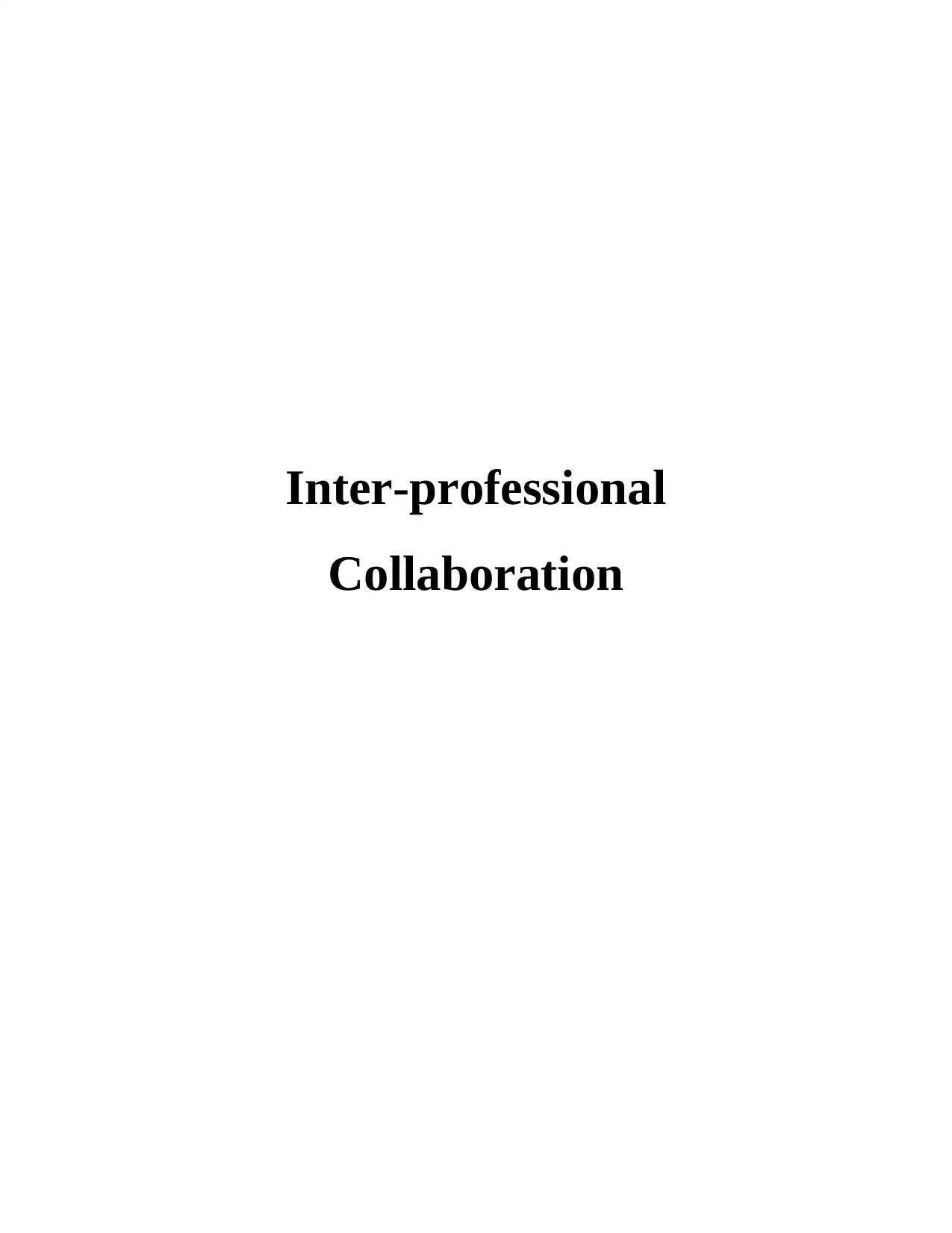
Inter-professional
Collaboration
Collaboration
Secure Best Marks with AI Grader
Need help grading? Try our AI Grader for instant feedback on your assignments.
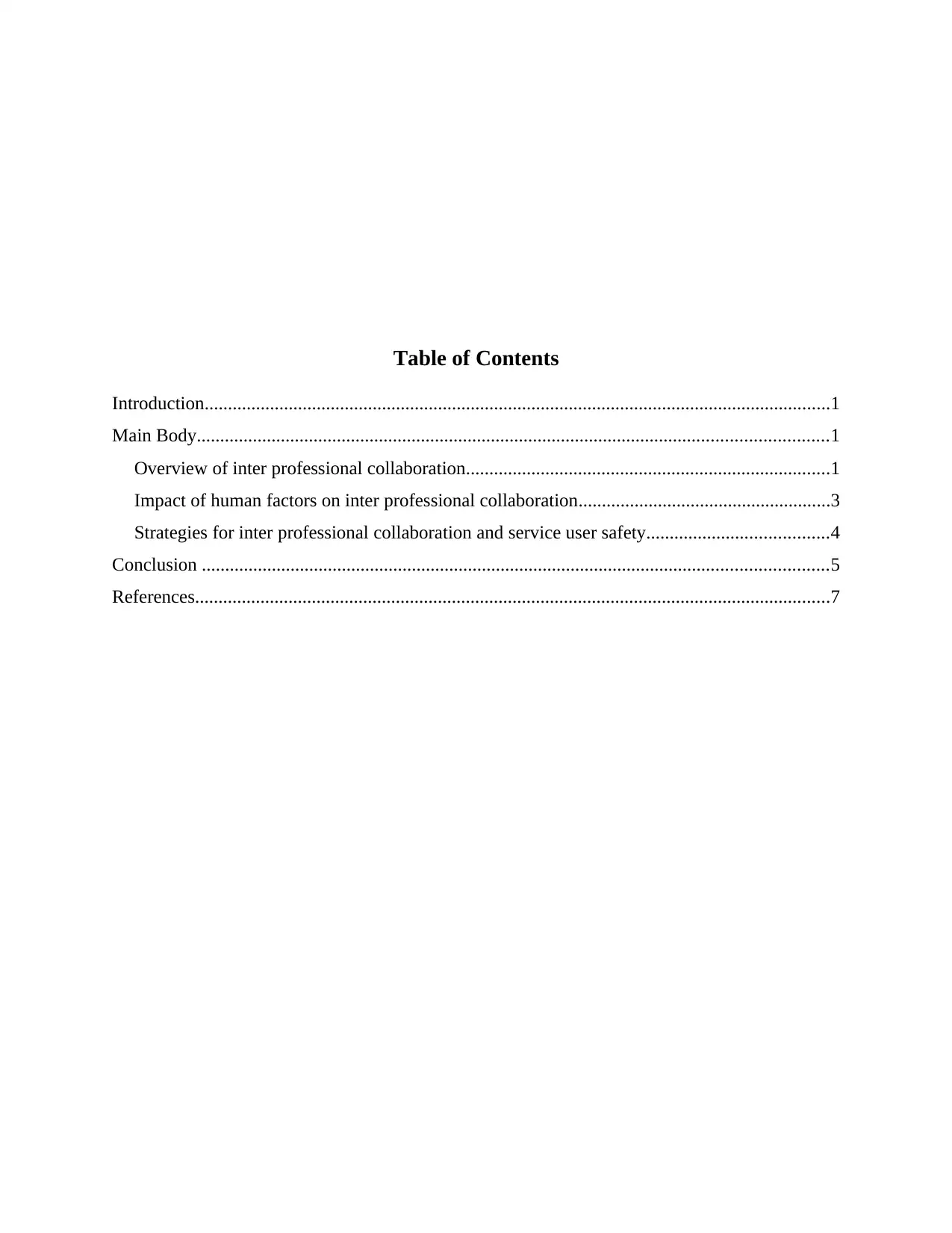
Table of Contents
Introduction......................................................................................................................................1
Main Body.......................................................................................................................................1
Overview of inter professional collaboration..............................................................................1
Impact of human factors on inter professional collaboration......................................................3
Strategies for inter professional collaboration and service user safety.......................................4
Conclusion ......................................................................................................................................5
References........................................................................................................................................7
Introduction......................................................................................................................................1
Main Body.......................................................................................................................................1
Overview of inter professional collaboration..............................................................................1
Impact of human factors on inter professional collaboration......................................................3
Strategies for inter professional collaboration and service user safety.......................................4
Conclusion ......................................................................................................................................5
References........................................................................................................................................7

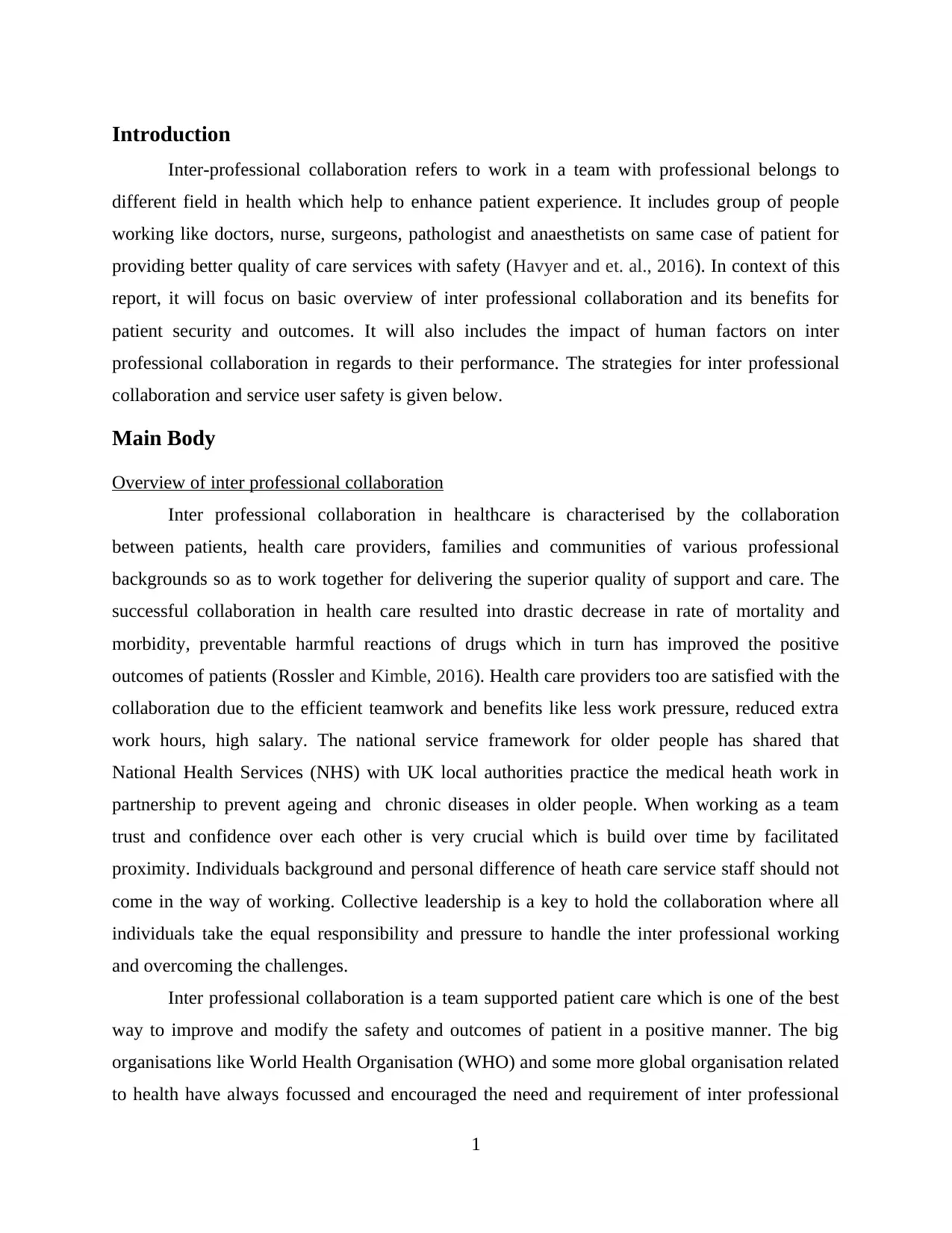
Introduction
Inter-professional collaboration refers to work in a team with professional belongs to
different field in health which help to enhance patient experience. It includes group of people
working like doctors, nurse, surgeons, pathologist and anaesthetists on same case of patient for
providing better quality of care services with safety (Havyer and et. al., 2016). In context of this
report, it will focus on basic overview of inter professional collaboration and its benefits for
patient security and outcomes. It will also includes the impact of human factors on inter
professional collaboration in regards to their performance. The strategies for inter professional
collaboration and service user safety is given below.
Main Body
Overview of inter professional collaboration
Inter professional collaboration in healthcare is characterised by the collaboration
between patients, health care providers, families and communities of various professional
backgrounds so as to work together for delivering the superior quality of support and care. The
successful collaboration in health care resulted into drastic decrease in rate of mortality and
morbidity, preventable harmful reactions of drugs which in turn has improved the positive
outcomes of patients (Rossler and Kimble, 2016). Health care providers too are satisfied with the
collaboration due to the efficient teamwork and benefits like less work pressure, reduced extra
work hours, high salary. The national service framework for older people has shared that
National Health Services (NHS) with UK local authorities practice the medical heath work in
partnership to prevent ageing and chronic diseases in older people. When working as a team
trust and confidence over each other is very crucial which is build over time by facilitated
proximity. Individuals background and personal difference of heath care service staff should not
come in the way of working. Collective leadership is a key to hold the collaboration where all
individuals take the equal responsibility and pressure to handle the inter professional working
and overcoming the challenges.
Inter professional collaboration is a team supported patient care which is one of the best
way to improve and modify the safety and outcomes of patient in a positive manner. The big
organisations like World Health Organisation (WHO) and some more global organisation related
to health have always focussed and encouraged the need and requirement of inter professional
1
Inter-professional collaboration refers to work in a team with professional belongs to
different field in health which help to enhance patient experience. It includes group of people
working like doctors, nurse, surgeons, pathologist and anaesthetists on same case of patient for
providing better quality of care services with safety (Havyer and et. al., 2016). In context of this
report, it will focus on basic overview of inter professional collaboration and its benefits for
patient security and outcomes. It will also includes the impact of human factors on inter
professional collaboration in regards to their performance. The strategies for inter professional
collaboration and service user safety is given below.
Main Body
Overview of inter professional collaboration
Inter professional collaboration in healthcare is characterised by the collaboration
between patients, health care providers, families and communities of various professional
backgrounds so as to work together for delivering the superior quality of support and care. The
successful collaboration in health care resulted into drastic decrease in rate of mortality and
morbidity, preventable harmful reactions of drugs which in turn has improved the positive
outcomes of patients (Rossler and Kimble, 2016). Health care providers too are satisfied with the
collaboration due to the efficient teamwork and benefits like less work pressure, reduced extra
work hours, high salary. The national service framework for older people has shared that
National Health Services (NHS) with UK local authorities practice the medical heath work in
partnership to prevent ageing and chronic diseases in older people. When working as a team
trust and confidence over each other is very crucial which is build over time by facilitated
proximity. Individuals background and personal difference of heath care service staff should not
come in the way of working. Collective leadership is a key to hold the collaboration where all
individuals take the equal responsibility and pressure to handle the inter professional working
and overcoming the challenges.
Inter professional collaboration is a team supported patient care which is one of the best
way to improve and modify the safety and outcomes of patient in a positive manner. The big
organisations like World Health Organisation (WHO) and some more global organisation related
to health have always focussed and encouraged the need and requirement of inter professional
1
Secure Best Marks with AI Grader
Need help grading? Try our AI Grader for instant feedback on your assignments.
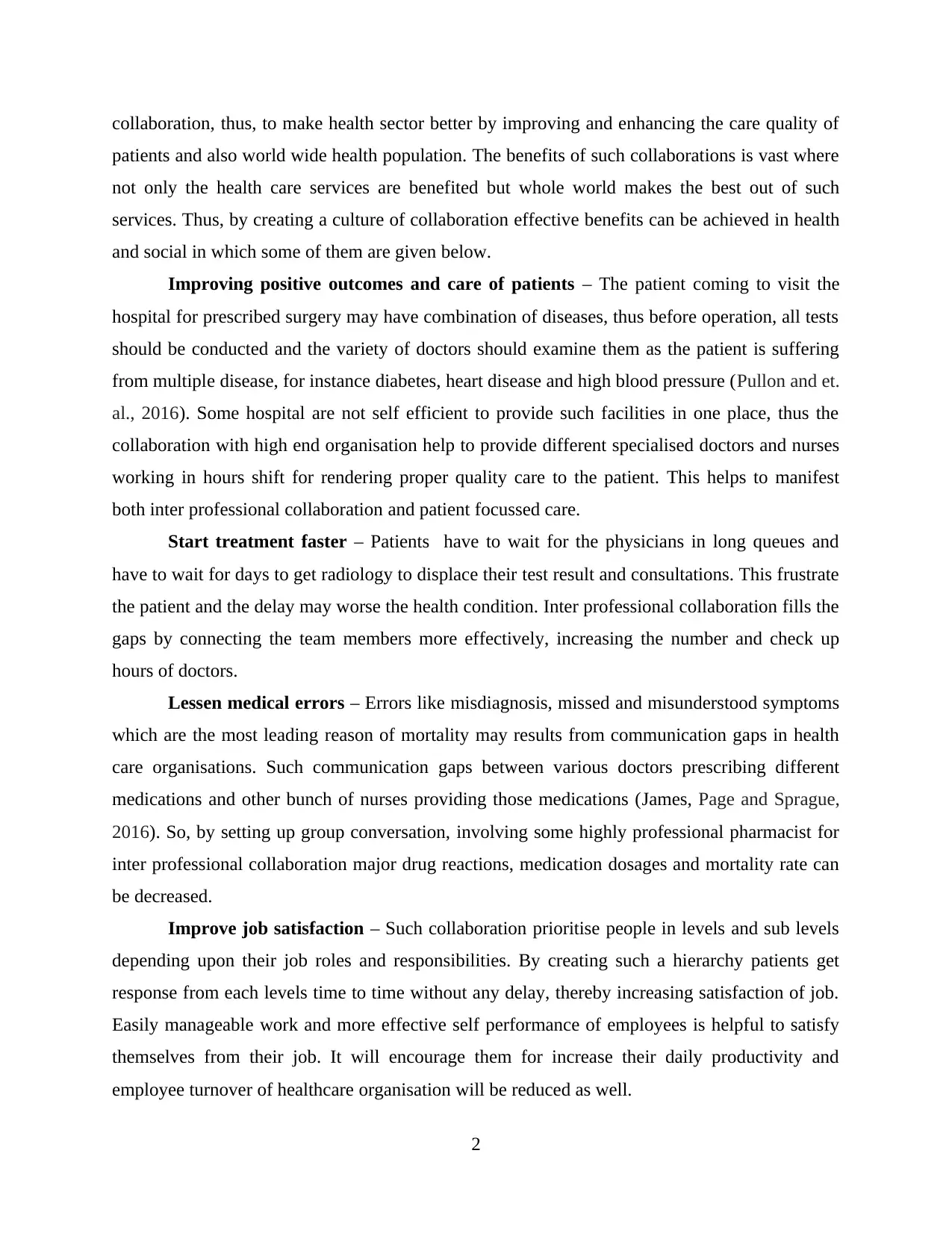
collaboration, thus, to make health sector better by improving and enhancing the care quality of
patients and also world wide health population. The benefits of such collaborations is vast where
not only the health care services are benefited but whole world makes the best out of such
services. Thus, by creating a culture of collaboration effective benefits can be achieved in health
and social in which some of them are given below.
Improving positive outcomes and care of patients – The patient coming to visit the
hospital for prescribed surgery may have combination of diseases, thus before operation, all tests
should be conducted and the variety of doctors should examine them as the patient is suffering
from multiple disease, for instance diabetes, heart disease and high blood pressure (Pullon and et.
al., 2016). Some hospital are not self efficient to provide such facilities in one place, thus the
collaboration with high end organisation help to provide different specialised doctors and nurses
working in hours shift for rendering proper quality care to the patient. This helps to manifest
both inter professional collaboration and patient focussed care.
Start treatment faster – Patients have to wait for the physicians in long queues and
have to wait for days to get radiology to displace their test result and consultations. This frustrate
the patient and the delay may worse the health condition. Inter professional collaboration fills the
gaps by connecting the team members more effectively, increasing the number and check up
hours of doctors.
Lessen medical errors – Errors like misdiagnosis, missed and misunderstood symptoms
which are the most leading reason of mortality may results from communication gaps in health
care organisations. Such communication gaps between various doctors prescribing different
medications and other bunch of nurses providing those medications (James, Page and Sprague,
2016). So, by setting up group conversation, involving some highly professional pharmacist for
inter professional collaboration major drug reactions, medication dosages and mortality rate can
be decreased.
Improve job satisfaction – Such collaboration prioritise people in levels and sub levels
depending upon their job roles and responsibilities. By creating such a hierarchy patients get
response from each levels time to time without any delay, thereby increasing satisfaction of job.
Easily manageable work and more effective self performance of employees is helpful to satisfy
themselves from their job. It will encourage them for increase their daily productivity and
employee turnover of healthcare organisation will be reduced as well.
2
patients and also world wide health population. The benefits of such collaborations is vast where
not only the health care services are benefited but whole world makes the best out of such
services. Thus, by creating a culture of collaboration effective benefits can be achieved in health
and social in which some of them are given below.
Improving positive outcomes and care of patients – The patient coming to visit the
hospital for prescribed surgery may have combination of diseases, thus before operation, all tests
should be conducted and the variety of doctors should examine them as the patient is suffering
from multiple disease, for instance diabetes, heart disease and high blood pressure (Pullon and et.
al., 2016). Some hospital are not self efficient to provide such facilities in one place, thus the
collaboration with high end organisation help to provide different specialised doctors and nurses
working in hours shift for rendering proper quality care to the patient. This helps to manifest
both inter professional collaboration and patient focussed care.
Start treatment faster – Patients have to wait for the physicians in long queues and
have to wait for days to get radiology to displace their test result and consultations. This frustrate
the patient and the delay may worse the health condition. Inter professional collaboration fills the
gaps by connecting the team members more effectively, increasing the number and check up
hours of doctors.
Lessen medical errors – Errors like misdiagnosis, missed and misunderstood symptoms
which are the most leading reason of mortality may results from communication gaps in health
care organisations. Such communication gaps between various doctors prescribing different
medications and other bunch of nurses providing those medications (James, Page and Sprague,
2016). So, by setting up group conversation, involving some highly professional pharmacist for
inter professional collaboration major drug reactions, medication dosages and mortality rate can
be decreased.
Improve job satisfaction – Such collaboration prioritise people in levels and sub levels
depending upon their job roles and responsibilities. By creating such a hierarchy patients get
response from each levels time to time without any delay, thereby increasing satisfaction of job.
Easily manageable work and more effective self performance of employees is helpful to satisfy
themselves from their job. It will encourage them for increase their daily productivity and
employee turnover of healthcare organisation will be reduced as well.
2

Impact of human factors on inter professional collaboration
Human factors can be described relations between individuals along with their thinking,
creativity, productivity and job satisfaction. It also consist their way of working and establish
relations with other people at the time of executing their own tasks at work place. However, the
different skills and creativity of professional is responsible for developing conflicts which are
required to be managed in terms of increase outcomes of clinical procedures and activities
(Glaser and Suter, 2016). There are number of human factors which impacts on inter professional
collaboration in which few of them are explained further:
Hierarchy – This can be described as an effective system in an organisation where
people are ranked according to their status of authority. It can be considered an efficient
stratagem through which inter professional working can be improved by managing discipline
among groups to conduct various clinical tasks in proper manner. However, professionals will
obey their superior and perform in correct direction which is favourable to patients in terms of
gaining better quality of services to become disease free. In addition to this, hierarchy is suitable
to encourage people to work in a systematic manner which facilitate to increase patient safety as
well as outcomes respectively.
Resilience – The resilience refers to an ability of an individual to overcome with
problematic situations and difficulties at work. It requires the efforts of care practitioners learn
the technique of quickly recover with problems while working in inter professional collaboration
for patient well-being. However, it is favourable for them to solve issues easily and deliver
desired medical facilities to patient and improve safety as well (Barr and et. al., 2017). Moreover,
resilience is supportive to make professionals capable to recover with personal and tasks
problems which impact positively on treatment process which facilitate to deliver better quality
of care facilities for wellness of people. Additionally, it is required to organise effective training
sessions for practitioners who are going to perform in an inter professional collaboration for
enhancing their skills and abilities for achieving better clinical outcomes.
Different skills and creativity – The care practitioners working in inter-professional
collaboration belongs different specialised areas and their way of performing is different.
Basically, every person has their own thinking skills and creativities due to which occurrence of
conflicts between hem has more chances. However, it is necessary for them to understand others'
way of working and thoughts while cooperating with them in same tasks. Moreover, it has been
3
Human factors can be described relations between individuals along with their thinking,
creativity, productivity and job satisfaction. It also consist their way of working and establish
relations with other people at the time of executing their own tasks at work place. However, the
different skills and creativity of professional is responsible for developing conflicts which are
required to be managed in terms of increase outcomes of clinical procedures and activities
(Glaser and Suter, 2016). There are number of human factors which impacts on inter professional
collaboration in which few of them are explained further:
Hierarchy – This can be described as an effective system in an organisation where
people are ranked according to their status of authority. It can be considered an efficient
stratagem through which inter professional working can be improved by managing discipline
among groups to conduct various clinical tasks in proper manner. However, professionals will
obey their superior and perform in correct direction which is favourable to patients in terms of
gaining better quality of services to become disease free. In addition to this, hierarchy is suitable
to encourage people to work in a systematic manner which facilitate to increase patient safety as
well as outcomes respectively.
Resilience – The resilience refers to an ability of an individual to overcome with
problematic situations and difficulties at work. It requires the efforts of care practitioners learn
the technique of quickly recover with problems while working in inter professional collaboration
for patient well-being. However, it is favourable for them to solve issues easily and deliver
desired medical facilities to patient and improve safety as well (Barr and et. al., 2017). Moreover,
resilience is supportive to make professionals capable to recover with personal and tasks
problems which impact positively on treatment process which facilitate to deliver better quality
of care facilities for wellness of people. Additionally, it is required to organise effective training
sessions for practitioners who are going to perform in an inter professional collaboration for
enhancing their skills and abilities for achieving better clinical outcomes.
Different skills and creativity – The care practitioners working in inter-professional
collaboration belongs different specialised areas and their way of performing is different.
Basically, every person has their own thinking skills and creativities due to which occurrence of
conflicts between hem has more chances. However, it is necessary for them to understand others'
way of working and thoughts while cooperating with them in same tasks. Moreover, it has been
3
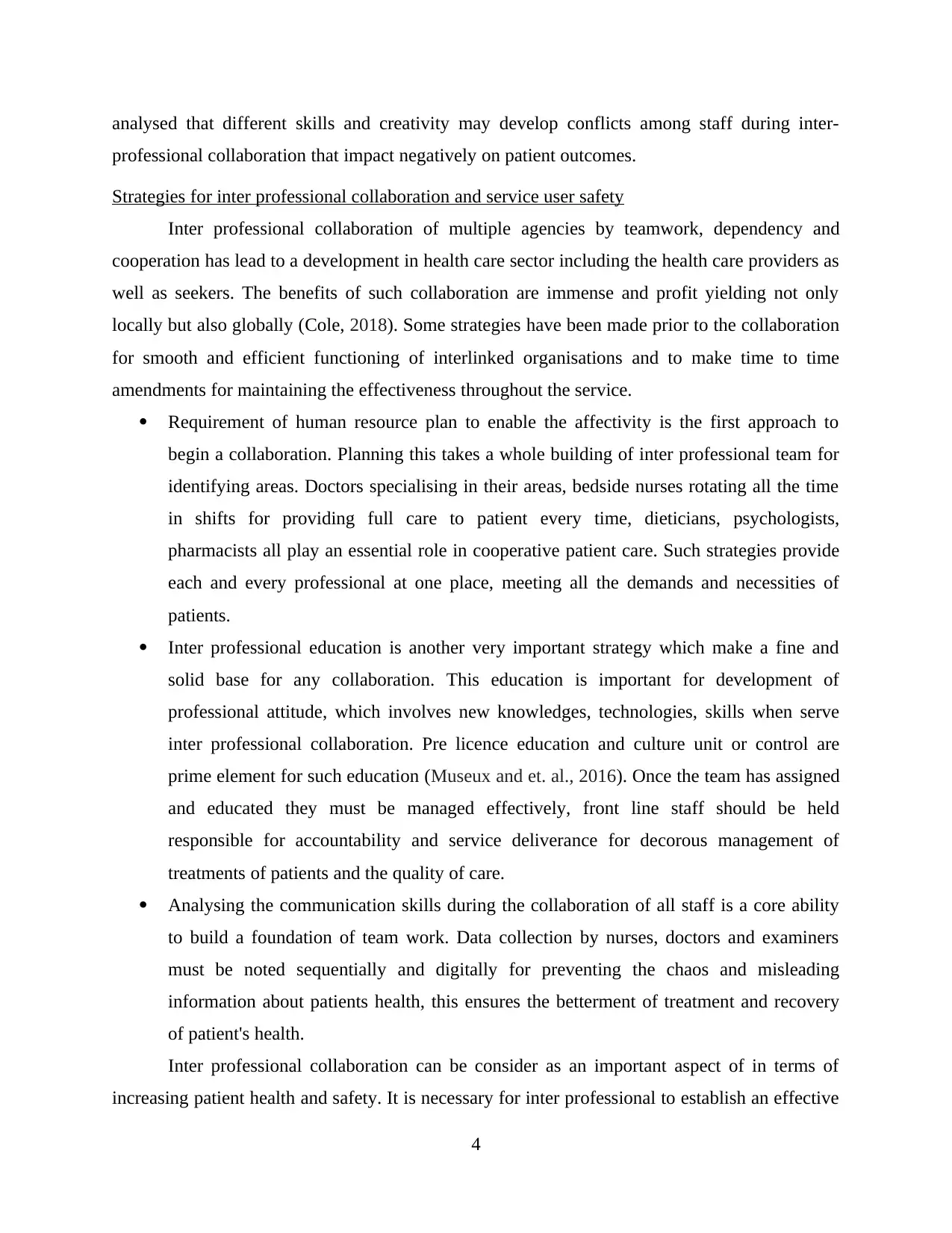
analysed that different skills and creativity may develop conflicts among staff during inter-
professional collaboration that impact negatively on patient outcomes.
Strategies for inter professional collaboration and service user safety
Inter professional collaboration of multiple agencies by teamwork, dependency and
cooperation has lead to a development in health care sector including the health care providers as
well as seekers. The benefits of such collaboration are immense and profit yielding not only
locally but also globally (Cole, 2018). Some strategies have been made prior to the collaboration
for smooth and efficient functioning of interlinked organisations and to make time to time
amendments for maintaining the effectiveness throughout the service.
Requirement of human resource plan to enable the affectivity is the first approach to
begin a collaboration. Planning this takes a whole building of inter professional team for
identifying areas. Doctors specialising in their areas, bedside nurses rotating all the time
in shifts for providing full care to patient every time, dieticians, psychologists,
pharmacists all play an essential role in cooperative patient care. Such strategies provide
each and every professional at one place, meeting all the demands and necessities of
patients.
Inter professional education is another very important strategy which make a fine and
solid base for any collaboration. This education is important for development of
professional attitude, which involves new knowledges, technologies, skills when serve
inter professional collaboration. Pre licence education and culture unit or control are
prime element for such education (Museux and et. al., 2016). Once the team has assigned
and educated they must be managed effectively, front line staff should be held
responsible for accountability and service deliverance for decorous management of
treatments of patients and the quality of care.
Analysing the communication skills during the collaboration of all staff is a core ability
to build a foundation of team work. Data collection by nurses, doctors and examiners
must be noted sequentially and digitally for preventing the chaos and misleading
information about patients health, this ensures the betterment of treatment and recovery
of patient's health.
Inter professional collaboration can be consider as an important aspect of in terms of
increasing patient health and safety. It is necessary for inter professional to establish an effective
4
professional collaboration that impact negatively on patient outcomes.
Strategies for inter professional collaboration and service user safety
Inter professional collaboration of multiple agencies by teamwork, dependency and
cooperation has lead to a development in health care sector including the health care providers as
well as seekers. The benefits of such collaboration are immense and profit yielding not only
locally but also globally (Cole, 2018). Some strategies have been made prior to the collaboration
for smooth and efficient functioning of interlinked organisations and to make time to time
amendments for maintaining the effectiveness throughout the service.
Requirement of human resource plan to enable the affectivity is the first approach to
begin a collaboration. Planning this takes a whole building of inter professional team for
identifying areas. Doctors specialising in their areas, bedside nurses rotating all the time
in shifts for providing full care to patient every time, dieticians, psychologists,
pharmacists all play an essential role in cooperative patient care. Such strategies provide
each and every professional at one place, meeting all the demands and necessities of
patients.
Inter professional education is another very important strategy which make a fine and
solid base for any collaboration. This education is important for development of
professional attitude, which involves new knowledges, technologies, skills when serve
inter professional collaboration. Pre licence education and culture unit or control are
prime element for such education (Museux and et. al., 2016). Once the team has assigned
and educated they must be managed effectively, front line staff should be held
responsible for accountability and service deliverance for decorous management of
treatments of patients and the quality of care.
Analysing the communication skills during the collaboration of all staff is a core ability
to build a foundation of team work. Data collection by nurses, doctors and examiners
must be noted sequentially and digitally for preventing the chaos and misleading
information about patients health, this ensures the betterment of treatment and recovery
of patient's health.
Inter professional collaboration can be consider as an important aspect of in terms of
increasing patient health and safety. It is necessary for inter professional to establish an effective
4
Paraphrase This Document
Need a fresh take? Get an instant paraphrase of this document with our AI Paraphraser
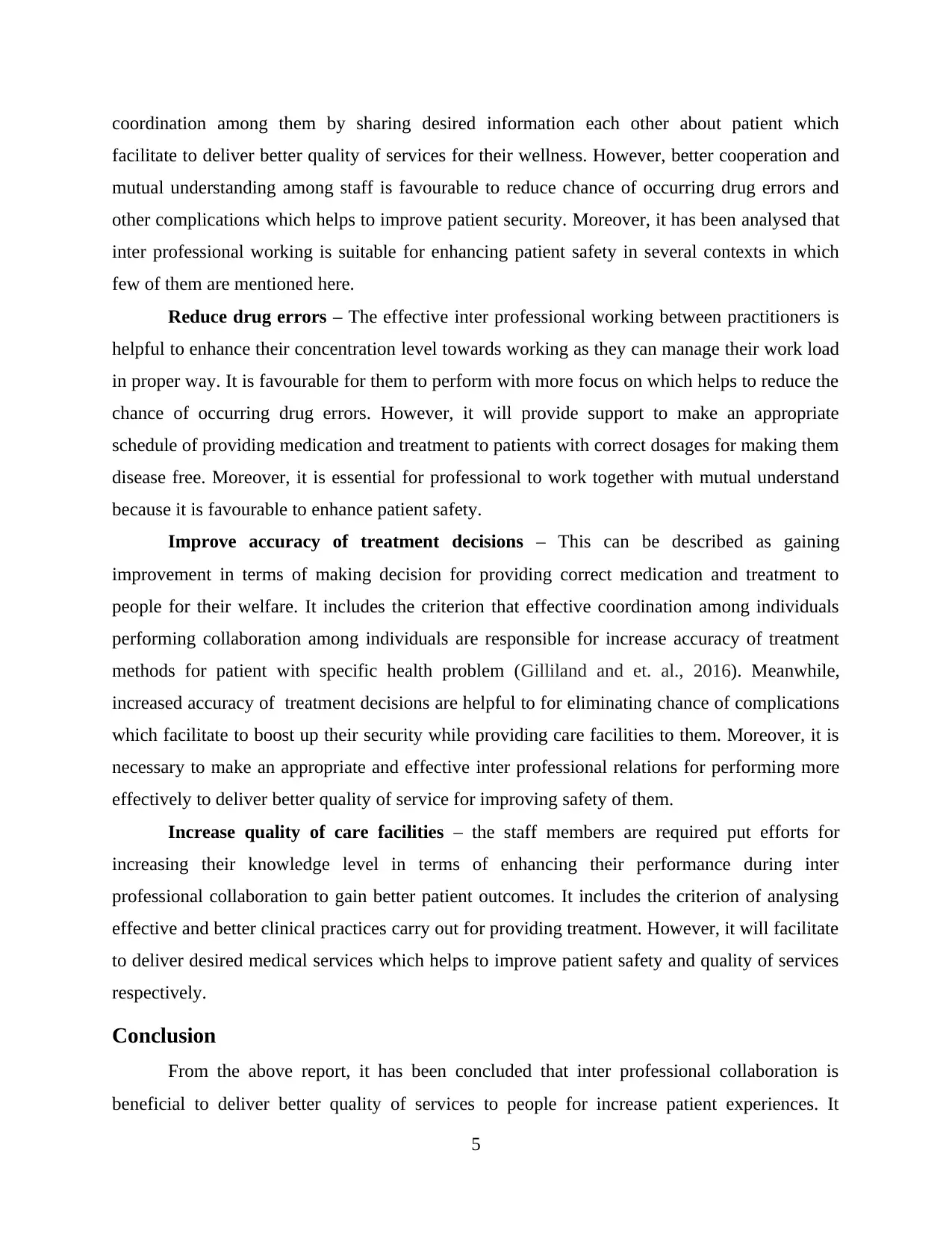
coordination among them by sharing desired information each other about patient which
facilitate to deliver better quality of services for their wellness. However, better cooperation and
mutual understanding among staff is favourable to reduce chance of occurring drug errors and
other complications which helps to improve patient security. Moreover, it has been analysed that
inter professional working is suitable for enhancing patient safety in several contexts in which
few of them are mentioned here.
Reduce drug errors – The effective inter professional working between practitioners is
helpful to enhance their concentration level towards working as they can manage their work load
in proper way. It is favourable for them to perform with more focus on which helps to reduce the
chance of occurring drug errors. However, it will provide support to make an appropriate
schedule of providing medication and treatment to patients with correct dosages for making them
disease free. Moreover, it is essential for professional to work together with mutual understand
because it is favourable to enhance patient safety.
Improve accuracy of treatment decisions – This can be described as gaining
improvement in terms of making decision for providing correct medication and treatment to
people for their welfare. It includes the criterion that effective coordination among individuals
performing collaboration among individuals are responsible for increase accuracy of treatment
methods for patient with specific health problem (Gilliland and et. al., 2016). Meanwhile,
increased accuracy of treatment decisions are helpful to for eliminating chance of complications
which facilitate to boost up their security while providing care facilities to them. Moreover, it is
necessary to make an appropriate and effective inter professional relations for performing more
effectively to deliver better quality of service for improving safety of them.
Increase quality of care facilities – the staff members are required put efforts for
increasing their knowledge level in terms of enhancing their performance during inter
professional collaboration to gain better patient outcomes. It includes the criterion of analysing
effective and better clinical practices carry out for providing treatment. However, it will facilitate
to deliver desired medical services which helps to improve patient safety and quality of services
respectively.
Conclusion
From the above report, it has been concluded that inter professional collaboration is
beneficial to deliver better quality of services to people for increase patient experiences. It
5
facilitate to deliver better quality of services for their wellness. However, better cooperation and
mutual understanding among staff is favourable to reduce chance of occurring drug errors and
other complications which helps to improve patient security. Moreover, it has been analysed that
inter professional working is suitable for enhancing patient safety in several contexts in which
few of them are mentioned here.
Reduce drug errors – The effective inter professional working between practitioners is
helpful to enhance their concentration level towards working as they can manage their work load
in proper way. It is favourable for them to perform with more focus on which helps to reduce the
chance of occurring drug errors. However, it will provide support to make an appropriate
schedule of providing medication and treatment to patients with correct dosages for making them
disease free. Moreover, it is essential for professional to work together with mutual understand
because it is favourable to enhance patient safety.
Improve accuracy of treatment decisions – This can be described as gaining
improvement in terms of making decision for providing correct medication and treatment to
people for their welfare. It includes the criterion that effective coordination among individuals
performing collaboration among individuals are responsible for increase accuracy of treatment
methods for patient with specific health problem (Gilliland and et. al., 2016). Meanwhile,
increased accuracy of treatment decisions are helpful to for eliminating chance of complications
which facilitate to boost up their security while providing care facilities to them. Moreover, it is
necessary to make an appropriate and effective inter professional relations for performing more
effectively to deliver better quality of service for improving safety of them.
Increase quality of care facilities – the staff members are required put efforts for
increasing their knowledge level in terms of enhancing their performance during inter
professional collaboration to gain better patient outcomes. It includes the criterion of analysing
effective and better clinical practices carry out for providing treatment. However, it will facilitate
to deliver desired medical services which helps to improve patient safety and quality of services
respectively.
Conclusion
From the above report, it has been concluded that inter professional collaboration is
beneficial to deliver better quality of services to people for increase patient experiences. It
5
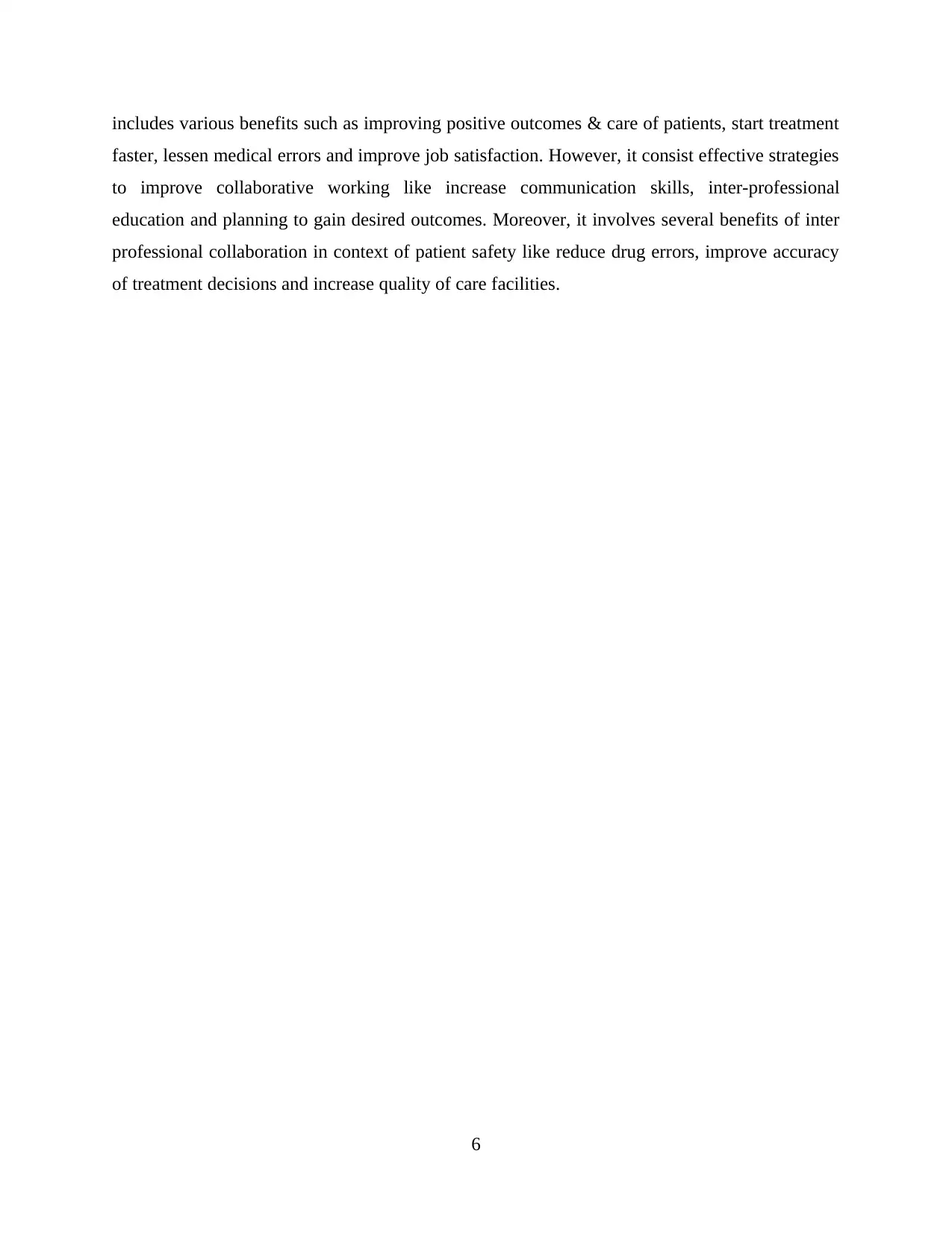
includes various benefits such as improving positive outcomes & care of patients, start treatment
faster, lessen medical errors and improve job satisfaction. However, it consist effective strategies
to improve collaborative working like increase communication skills, inter-professional
education and planning to gain desired outcomes. Moreover, it involves several benefits of inter
professional collaboration in context of patient safety like reduce drug errors, improve accuracy
of treatment decisions and increase quality of care facilities.
6
faster, lessen medical errors and improve job satisfaction. However, it consist effective strategies
to improve collaborative working like increase communication skills, inter-professional
education and planning to gain desired outcomes. Moreover, it involves several benefits of inter
professional collaboration in context of patient safety like reduce drug errors, improve accuracy
of treatment decisions and increase quality of care facilities.
6

References
Books and journals
Barr, N. and et. al., 2017. Impact of information and communication technology on
interprofessional collaboration for chronic disease management: a systematic
review. Journal of health services research & policy, 22(4), pp.250-257.
Cole, J., 2018. Structural, organizational, and interpersonal factors influencing interprofessional
collaboration on sexual assault response teams. Journal of interpersonal
violence, 33(17), pp.2682-2703.
Gilliland, I. and et. al., 2016. Building cultural sensitivity and interprofessional collaboration
through a study abroad experience. Journal of Nursing Education, 55(1), pp.45-48.
Glaser, B. and Suter, E., 2016. Interprofessional collaboration and integration as experienced by
social workers in health care. Social work in health care, 55(5), pp.395-408.
Havyer, R.D. and et. al., 2016. Addressing the Interprofessional Collaboration Competencies of
the Association of American Medical Colleges: a systematic review of assessment
instruments in undergraduate medical education. Academic Medicine, 91(6), pp.865-
888.
James, T.A., Page, J.S. and Sprague, J., 2016. Promoting interprofessional collaboration in
oncology through a teamwork skills simulation programme. Journal of interprofessional
care, 30(4), pp.539-541.
Museux, A.C. and et. al., 2016. Improving interprofessional collaboration: The effect of training
in nonviolent communication. Social work in health care, 55(6), pp.427-439.
Pullon, S. and et. al., 2016. Observation of interprofessional collaboration in primary care
practice: a multiple case study. Journal of interprofessional care, 30(6), pp.787-794.
Rossler, K.L. and Kimble, L.P., 2016. Capturing readiness to learn and collaboration as explored
with an interprofessional simulation scenario: A mixed-methods research study. Nurse
education today, 36, pp.348-353.
7
Books and journals
Barr, N. and et. al., 2017. Impact of information and communication technology on
interprofessional collaboration for chronic disease management: a systematic
review. Journal of health services research & policy, 22(4), pp.250-257.
Cole, J., 2018. Structural, organizational, and interpersonal factors influencing interprofessional
collaboration on sexual assault response teams. Journal of interpersonal
violence, 33(17), pp.2682-2703.
Gilliland, I. and et. al., 2016. Building cultural sensitivity and interprofessional collaboration
through a study abroad experience. Journal of Nursing Education, 55(1), pp.45-48.
Glaser, B. and Suter, E., 2016. Interprofessional collaboration and integration as experienced by
social workers in health care. Social work in health care, 55(5), pp.395-408.
Havyer, R.D. and et. al., 2016. Addressing the Interprofessional Collaboration Competencies of
the Association of American Medical Colleges: a systematic review of assessment
instruments in undergraduate medical education. Academic Medicine, 91(6), pp.865-
888.
James, T.A., Page, J.S. and Sprague, J., 2016. Promoting interprofessional collaboration in
oncology through a teamwork skills simulation programme. Journal of interprofessional
care, 30(4), pp.539-541.
Museux, A.C. and et. al., 2016. Improving interprofessional collaboration: The effect of training
in nonviolent communication. Social work in health care, 55(6), pp.427-439.
Pullon, S. and et. al., 2016. Observation of interprofessional collaboration in primary care
practice: a multiple case study. Journal of interprofessional care, 30(6), pp.787-794.
Rossler, K.L. and Kimble, L.P., 2016. Capturing readiness to learn and collaboration as explored
with an interprofessional simulation scenario: A mixed-methods research study. Nurse
education today, 36, pp.348-353.
7
1 out of 10
Related Documents
Your All-in-One AI-Powered Toolkit for Academic Success.
+13062052269
info@desklib.com
Available 24*7 on WhatsApp / Email
![[object Object]](/_next/static/media/star-bottom.7253800d.svg)
Unlock your academic potential
© 2024 | Zucol Services PVT LTD | All rights reserved.





